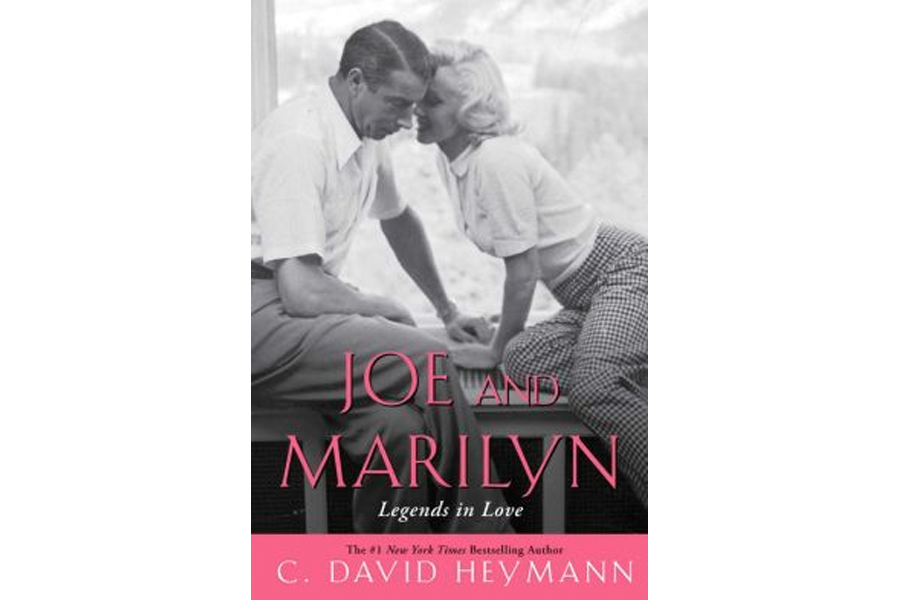'Joe and Marilyn' considers the poignant, troubled love affair between Joe DiMaggio and Marilyn Monroe
Loading...
Our culture revolves around celebrities. Their lives drive not just fashion and entertainment but news cycles. Two of the brightest stars caught in this current were Joe DiMaggio and Marilyn Monroe. Both embodied the American dream of rags-to-riches success and captured the imagination in ways that still resonate today. That they became husband and wife only intensified the adulation and scrutiny by the public and press, which was distasteful to the intensely private DiMaggio, though more appealing to Monroe, who was still a young and rising star.
Their relationship is the subject of C. David Heymann’s Joe and Marilyn: Legends in Love. The author of several celebrity bios, Heymann specializes in steamy figures, as with his “intimate biography” of Elizabeth Taylor or the bestseller “Bobby and Jackie.” “Joe and Marilyn” is a double-biography hinged together by their relationship.
Both Monroe and DiMaggio came from impoverished backgrounds, but his was more stable. One of nine children in a San Francisco immigrant fishing family, Joe worked to earn his keep. His father, Giuseppe, opposed Joe playing baseball, but his mother convinced Giuseppe to let him. Giuseppe came around quickly with the ascent of Joe and two of his brothers to the major leagues.
Marilyn, born Norma Jean Baker, was, by contrast, shunted from one foster home to another, landing with families who were negligent at best and abusive at worst. Her mother gave her up in infancy, only to reclaim her as a seven-year-old. Ultimately diagnosed and institutionalized as a paranoid schizophrenic, Gladys Baker’s fate haunted Monroe for the rest of her life.
The two became a couple when a friend arranged a meeting at Joe’s request. (Notoriously late, Marilyn kept him waiting over an hour.) Their marriage lasted just nine months, but they were off-and-on lovers afterwards and at the time of her death were (re)engaged.
Neither was well suited for marriage.
Joe was controlling and abusive. His first wife gave up a career in entertainment to stay at home (while Joe philandered) and raised their son (whom Joe ignored). Joe deluded himself that Marilyn would do the same. Already retired, he grew envious of the attention she received, especially as a sex symbol. (Being called “Mr. Marilyn Monroe” in Japan didn’t go over well.) She, in turn, cheated on and jilted him.
How they reunited is a compelling story, tied as it is to Marilyn’s unraveling and Joe’s growing devotion.
What is painfully clear from a simple viewing of her relatively small body of work is just how talented Monroe was and how limited was the range of roles she was allowed to play (see “dumb blonde”).
DiMaggio was conservative, but Marilyn was, as Ella Fitzgerald put it, “an unusual woman, a little ahead of her time.”
Monroe convinced a nightclub owner to break the color code so Fitzgerald could perform (Monroe came every night). She was the first woman to start her own film studio since Mary Pickford. Even her openness about sexuality was progressive (think “Sex and the City”) though also problematic, tied as it was to her exploitation by film producers and powerful men like the Kennedys.
The subtitle “legends in love” and the lipstick-pink cover of “Joe and Marilyn” keep romance in the foreground, but what’s in the background is, to my mind, more interesting, if less sexy – the Hollywood “studio system,” the Hays Code, and the expectations and limitations placed on women that Marilyn struggled against and which played a part in her destruction.
Heymann touches on this but spends little time explaining the studio system and barely mentions the Code, which dictated the sexual morality of films. Perhaps he assumes the average reader will already know this?
Heymann devotes more space to affairs, especially to the exploitation Marilyn suffered at the hands of the Kennedys, and the psychiatrists who doled out pills indiscriminately, some exploiting Monroe sexually themselves.
Anecdotes about DiMaggio’s construction of a life-sized Marilyn doll for – um, you get it – interested this reader less (ick). On the other hand, they’re germane, given that the subject of the book is two people’s "love lives," which were generally driven by sex that culminated in one-night stands or failed relationships.
DiMaggio’s story is, in the end, more bittersweet. As he aged, he softened, giving up alcohol and coming to Monroe’s aid whenever she was in need, regardless of the other men who were in her life. She was the love of his life, though whether another marriage would have lasted is anyone’s guess. He was, in any case, the one man on whom she could depend.
Elizabeth Toohey is a professor of English at Queensborough Community College, where she teaches journalism.








